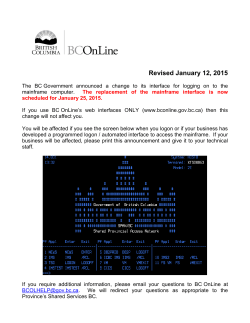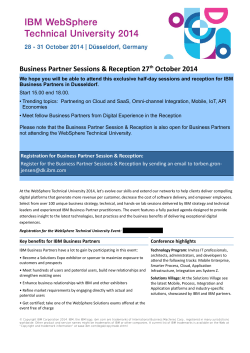
Next Meeting - Individual CMG Regions and SIGs
Connecticut Computer Measurement Group (Click on above to go to our web site.) Spring Conference and Vendor Day Meeting Friday April 17, 2015 To be held at the Courtyard by Marriott, Cromwell. All are welcome and Wi-Fi is available. (Click on above to go to hotel web site.) The first Connecticut Computer Measurement Group conference for the year is slated for Friday, April 17th. This Spring Meeting brings back our popular Vendor Day format, to which we invite many software and hardware companies to exhibit their offerings. Coffee and refreshments are served in the Vendor Hall, and a little more time is permitted between sessions for you to investigate their services. Fees earned on Vendor Day help us to keep our admission prices low during the rest of the year, as well. We have a really outstanding program this year. Please consider attending. Our spring vendor day conference is made possible with the help of our participating vendors. This year the following vendors will be exhibiting and providing information on their products and services: DataKinetics ♦ Dynatrace ♦ HP ♦ IBM ♦ Moviri ♦ CA ♦ Compuware ♦ MVS Solutions CCMG AGENDA Friday, April 17, 2015, Cromwell, CT Time Activity 7:45 – 8:15 Registration & Continental Breakfast (provided) 8:15 – 8:30 Introductory Remarks & Business Agenda 8:30 – 9:40 9:40 – 10:10 10:10– 11:20 11:20 – 12:30 12:30 – 1:40 1:40 – 2:10 2:10 – 3:20 Track 1 Track 2 Proactively managing Monthly License Charge for IBM mainframe software Managing Capacity and Performance for IBM PowerVM Virtualization z13 Hot Topics Capacity Management and Big-Data Andrew Jepeal – Compuware Debbie Sheetz – BMC Break -- Refreshments in the Exhibit Area Track 1 Track 2 Carol Creter – IBM Lunch (Provided) -- Dessert and Refreshments in the Exhibit Area Track 1 Track 2 5 Ingredients to Execute Application Performance Management on z/OS The Internet of Things and Its Impact on Our Application Economy Mike Horwitz – Dynatrace Jeremy Rossbach – CA Technologies Break -- Refreshments in the Exhibit Area Combined Sessions What’s in Your Nest? More than Ever – Less Is More! John Baker – MVS Solutions 3:20 – 3:25 Renato Bonomini – Moviri Presenting Your IT Business Case To Your Finance Partner Randy McCoy – DataKinetics Closing Remarks Preregistration Cost: $25 ∞ Preregister via email: Send a “Preregister me” email to: ccmgboard@gmail.com 8:30 – Dual Track Come learn ways to proactively manage Monthly License Charge (MLC) for IBM mainframe software Andrew Jepeal, Compuware Mainframe workloads are growing significantly as web, mobile and Internet of Things (IoT) applications drive increasing transaction volumes. Capabilities offered on the newly-debuted IBM z13 are also likely to attract new workloads—including high-performance analytics, Java and Linux®. This workload growth is precipitously driving up the Monthly License Charge (MLC) for IBM mainframe software, which for sub-capacity environments is generally impacted by the highest rolling four-hour average (R4HA) of mainframe utilization for all applications on each LPAR—measured in MSUs. Therefore IT can most effectively reduce its sizable IBM z Systems software costs by both 1) tuning each application to minimize its individual consumption of mainframe resources and 2) orchestrating application workloads to minimize the LPAR utilization peaks they generate collectively at any given time. Andrew Jepeal has over 30 years of experience in Mainframe Information Technology. A large part of Andrew’s career was spent as an MVS Systems Programmer with an emphasis on Performance Management and Capacity Planning. Just prior to joining the Compuware team, Andrew provided technical leadership to the MVS Systems Programming team for a major US retailer. Andrew has been a part of the Compuware team for over 15 years. During this time, he has held various positions, primarily related to Compuware’s Application Performance Management products. He has worked with many companies across various industries to help them achieve their mainframe APM objective and maximize their results. Managing Capacity and Performance for IBM PowerVM Virtualization - Debbie Sheetz, BMC What are the specific characteristics of IBM’s PowerVM virtualization? How do you apply capacity planning, performance analysis, or modeling techniques to this platform? What are some of the typical use cases for AIX? Two case studies demonstrating applying the techniques are presented. Debbie Sheetz is a Capacity Management Architect and Support Analyst based in BMC Customer Support, at the Waltham, Massachusetts/USA location. She provides applied solutions for performance analysis and capacity planning challenges for customers, business partners, and BMC field consultants. She works with product R&D and marketing on refining existing solutions and designing new solutions. Prior to working with Distributed Systems performance management products, she had extensive involvement with AS/400 and mainframe product support and development. Originally hired to work on the first version of BEST/1 at BGS Systems, she has 32 years of experience developing and supporting performance analysis software with BMC Software/BGS Systems. 10:10 – Dual Track z13 Hot Topics - Carol Creter, IBM In this fast paced, always new presentation the speaker will provide the latest information on System z and z/OS performance and capacity planning issues. Recent performance enhancements, gotchas, and recommendations will be reviewed with a focus on the z13 processor announcement. Also covered will be the latest information relating to recent performance APARs and ATS performance offerings. Carol Creter has spent 30 years in z/OS performance and Capacity Planning, with the last 23 focused on providing these services to IBM clients worldwide. Capacity Management and Big-Data - Renato Bonomini, Moviri Big-data solutions, led by Hadoop, are rapidly extending its footprint in large enterprises which are investing huge budgets to support new initiatives. For the ‘enterprise capacity planner’, Hadoop is a zoo of different types of workloads; even if companies are simply using Hadoop to store information (HDFS) there are many other applications (hdfs, hive, pig, impala, spark, solr, flume, to name a few). The traditional capacity questions still exist. However, each animal in this zoo behaves differently and, for example, there are significant differences in the two most common workloads “MapReduce” and “HBase. This leads to mainly three points of views for analysis to make sure service levels are achieved. This presentation focuses on providing guidelines for the capacity planner to understand how to translate existing techniques and framework and to adapt them to these new technologies: in most cases “what’s old is new again”. Renato Bonomini leads Moviri Inc., the US subsidiary of Moviri SpA headquartered in Milan Italy. A Digital Signal Processing engineer by training and big-data ante litteram while performing R&D for a major European oil and gas company, his expertise focus on: architecture and design of capacity optimization systems for large and very large enterprises; design or assessment of capacity management processes; capacity planning analysis for large-scale architectures; data crunching and visualization; High Performance Computing. His industry experience spans telco, oil and gas, finance, banking and insurance, leisure and travel, retail and public sectors. 12:30 – Dual Track 5 Ingredients to Execute Application Performance Management (APM) on z/OS - Mike Horwitz, Dynatrace “The translation of IT metrics into business meaning (value) is what APM is all about.” We will discuss the 5 most important and absolute necessary ingredients to get sustained APM done on the mainframe: 1) One view - Over all departments/teams, end-to-end from the tab on the mobile device down to the backend. 2) Top down - Start on 30.000 FT identifying the area of interest and dig into the details for root cause analysis. 3) Start early- Catch performance issues as early as possible and provide as much information as possible. 4) Focus - on the most critical applications/transactions and have a close watch on the key metrics. 5) Always on - monitor 100% of the transactions 24x7 to identify the root cause for unexpected increases. Mike Horwitz has spent 30 years in the software tool development industry, with the last 15 focused in the APM sector. As a senior Architect at Compuware and now Dynatrace, he has architected two different APM solutions, covering both java and z/OS (CICS and IMS). He truly bridges the gap between the “mainframe” and “distributed” worlds. He has a Computer Engineering degree from the University of Michigan, and holds several patents in software development. The Internet of Things and Its Impact on Our Application Economy - Jeremy Rossbach, CA Technologies The IoT wave is predicted to deliver almost 30 billion new connected devices. That’s a lot of new data fighting for capacity with existing enterprise systems. How will you process IoT data points based on business needs? How will you ensure sufficient data center and compute capacity for the applications that depend on IoT data? Learn how a more forward-looking capacity planning strategy is needed now more than ever to guarantee you will be able to ride the IoT wave. Jeremy Rossbach has spent the last 8 years at CA Technologies in a variety of roles, including Pre Sales Engineer to Product Management. Prior to CA, he spent 15 years in IT, across public and private sectors, managing data centers for startups, healthcare, financial and federal system integrators. Previous roles as data center administrator, engineer, architect and manager have provided him invaluable insights into the challenges and goals of IT consumers. 2:10 Dual Track What’s in Your Nest? More than Ever – Less Is More! – John Baker, MVS Solutions In RNI context, IBM says the number of concurrent tasks is the primary factor in workload performance, particularly with today’s high frequency processors. The z13 architecture has a vast capacity to serve multiple, concurrent applications. Regardless of the amount of work you throw at it, z/OS will do its best to provide some service to all workloads. As result, we generally throw all the work at the machine at once. Are you running too much or too little? Let’s look at some measurements and techniques to control how much concurrent work you are running. Cycles per instruction, Initiators, LPARs, Logical Processors and Weights are a few of the topics we’ll explore. You will find techniques to improve performance, throughput and efficiencies of your mainframe. Come and see just how much less you should be doing. John Baker has 20 years in the IT industry as both a customer and consultant. 15 years specializing in mainframe performance at a large international bank and 6 years in enterprise I/O performance with IntelliMagic. As a customer, John designed, implemented and maintained many critical projects such as WLM Goal Mode and GDPS/Data Mirroring. He has extensive experience with many performance analysis tools and techniques at the hardware, OS, and application levels. As a consultant, John has assisted many of the world's largest datacenters with their z/OS performance challenges and held Subject Area Chair positions with CMG for both Storage and Capacity Planning for several years. John has hosted many sessions at CMG, SHARE, etc. as well as several regional user groups. In 2013, John joined MVS Solutions as their Principal z Performance specialist. Presenting Your IT Business Case to Your Finance Partner - Randy McCoy, DataKinetics This presentation provides suggestions for IT personnel on how to present their business case to a finance partner to help increase the likelihood of getting the request for funding approved. The presentation provides a practical framework for presenting a business case, defines key finance terms, and gives illustrations and examples. Randy McCoy joined Ottawa based DataKinetics as CFO in June 2011. He is a Chartered Professional Accountant (CPA, CA) with over twenty years of experience in financial reporting and management for software, manufacturing, and professional services businesses. Prior to joining DataKinetics, Randy served as Finance Director at Kinaxis and as Sr. Finance Manager at Autodesk. Venue Courtyard by Marriott, Cromwell 4 Sebethe Drive · Cromwell, Connecticut 06416 Phone: (860) 635-1001 Preregistration Cost: $25 ∞ Preregister via email: Send a “Preregister me” email to: ccmgboard@gmail.com
© Copyright 2025










